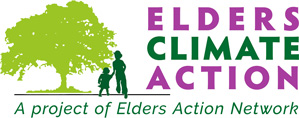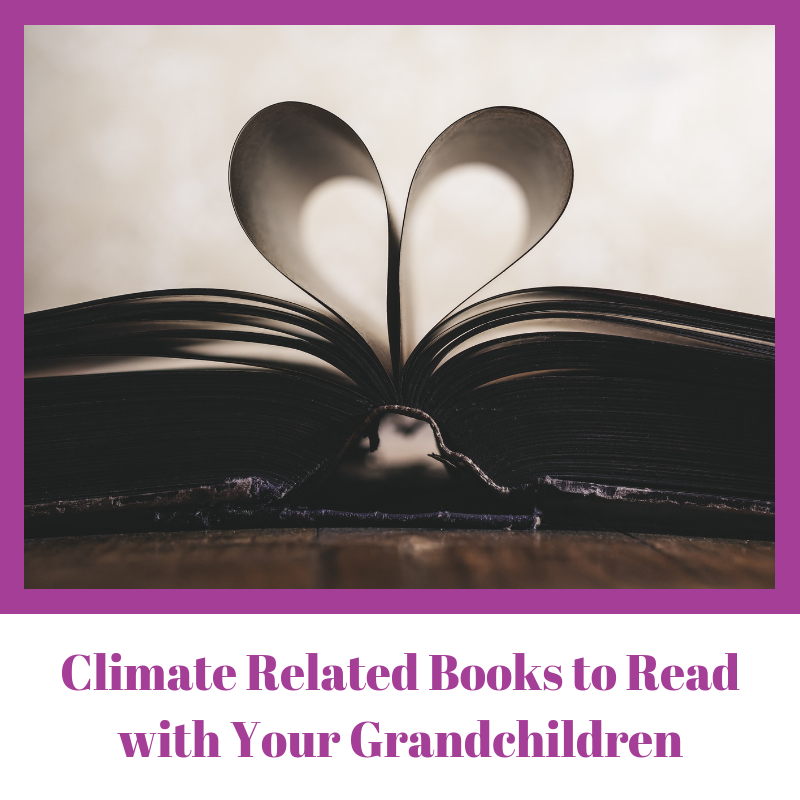
Books to Read With Your Grandchildren:
Reading can provide wonderful bonding time with your grandchild. Why not focus reading time on exploring the planet and discussing climate change! We found a few books that make these conversations easier. If you have suggestions or recommendations please let us know. Please review all content prior to sharing with your grandchildren to determine if it is age appropriate.
| Videos to Watch with Your Grandchildren | Books to Read With Your Grandchildren | Online Resources to Explore with Your Grandchildren |
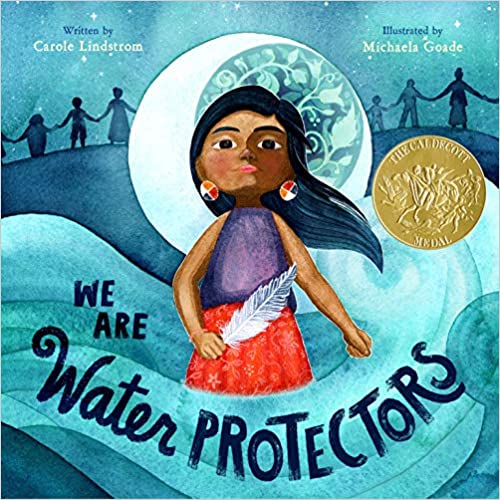 | We Are Water Protectors by Carole Lindstrom Winner of the 2021 Caldecott Medal. Inspired by the many Indigenous-led movements across North America, We Are Water Protectors issues an urgent rallying cry to safeguard the Earth’s water from harm and corruption―a bold and lyrical picture book written by Carole Lindstrom and vibrantly illustrated by Michaela Goade. Water is the first medicine. When a black snake threatens to destroy the Earth |
 | How to Talk to Your Kids about Climate Change by Harriet Shugarman Building grit and hope in the face of the climate emergency With catastrophic global warming already baked into the climate system, today’s children face a future entirely unlike that of their parents. Yet how can we maintain hope and make a difference in the face of overwhelming evidence of the climate crisis? Help is at hand. Written by Harriet Shugarman – the Climate Mama and trusted advisor to parents – How to Talk to Your Kids About Climate Change provides tools and strategies for parents to explain the climate emergency to their children and galvanize positive action. |
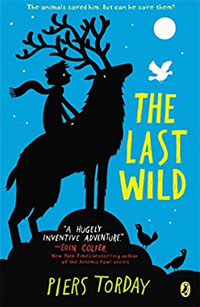 | The Last Wildby Piers TordayIn a world where animals are slowly fading into extinction, 12-year-old Kester Jaynes feels as if he hardly exists either. He’s been locked away in a home for troubled children and is unable to speak a word. Then one night, a flock of talking pigeons and a bossy cockroach come to help him escape, and he discovers that he can speak — to them. And the animals need him. Only Kester, with the aid of a stubborn, curious girl named Polly, can help them survive. The animals saved Kester. But can he save them? |
 | Exodusby Julie BertagnaIt is 2099 – and the world is gradually drowning, as mighty Arctic ice floes melt, the seas rise, and land disappears forever beneath storm-tossed waves. For 15-year-old Mara, her family and community, huddled on the fast-disappearing island of Wing, the new century brings flight. Packed into tiny boats, a terrifying journey begins to a bizarre city that rises into the sky, built on the drowned remains of the ancient city of Glasgow. But even here there is no safety and, shut out of the city, Mara realizes they are asylum-seekers in a world torn between high-tech wizardry and the most primitive injustice. To save her people, Mara must not only find a way into the city but also search for a new land and a new home. |
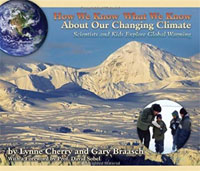 | How We Know What We Know about Our Changing Climateby Lynne Cherry and Gary BraaschWhen the weather changes daily, how do we really know that Earth’s climate is changing? Here is the science behind the headlines – evidence from flowers, butterflies, birds, frogs, trees, glaciers and much more, gathered by scientists from all over the world, sometimes with assistance from young “citizen-scientists.” And here is what young people, and their families and teachers, can do to learn about climate change and take action. Kids can make a difference! This book combines the talents of Lynne Cherry, the leading children’s environmental writer/illustrator and author of The Great Kapok Tree, and the late Gary Braasch, award-winning photojournalist and author of Earth Under Fire: How Global Warming is Changing the World. |
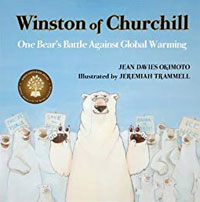 | Winston of Churchill: One Bear’s Battle Against Global Warmingby Jean Davies Okimoto, Illustrated by Jeremiah TrammelChurchill, Manitoba, is the polar bear capital of the world. Every winter, tourists flock to the tiny town to watch the bears hunt and frolic on the frozen waters of the Hudson Bay. This year, though, the tourists are in for a big surprise … Winston! A smart, fierce, brave bear, Winston of Churchill has noticed that his icy home is slowly melting away. He explains to the other bears why the ice is melting then, using the stirring words of his famous namesake, rallies the bears to convince humans to save their Arctic home. But in the process, Winston learns an unexpected lesson and realizes that he, too, must change his ways. This timely, funny story helps children understand that in the face of global warming, everyone must do their part, no matter how small. |
|
|
|
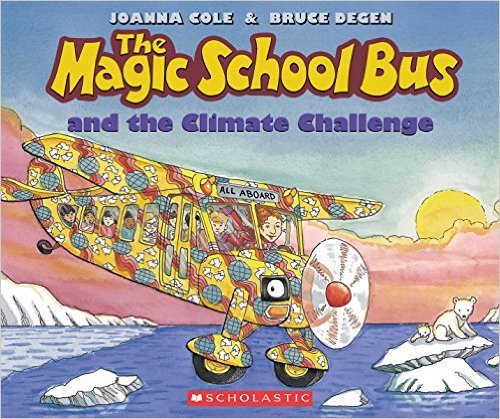 | The Magic School Bus and the Climate Challenge by Joanna Cole, Illustrated by Bruce Degen, 2010 Trust the bestselling science series of all time to get down to the facts on global warming, so kids can understand the crisis – and how they can help solve it. Like it or not, global warming is a hot topic, and it will affect the younger generation the most. So why not turn to the teacher kids like the most, Ms. Frizzle! Only the Friz can boil all the hoopla down to the scientific facts in a fun and informative way. With trademark simplicity and wit, Joanna Cole explains why the Earth is getting warmer, and Bruce Degen’s bright, action-filled illustrations make the science easy to understand and fun to learn. This team brings a new, improved understanding to climate change, engaging kids and empowering all.
|
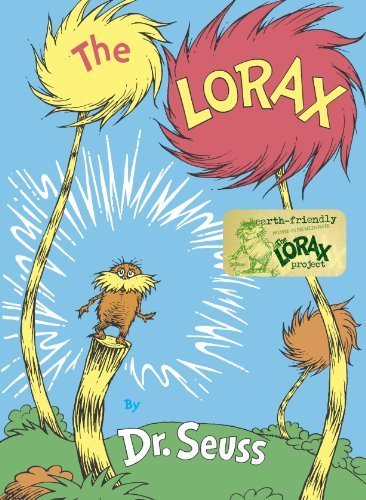 |
|
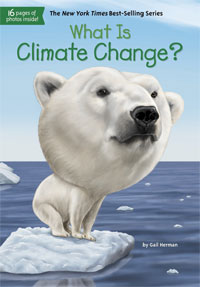 | What Is Climate Change? by Gail Herman, Illustrated by John Hinderliter, 2018 The Earth is definitely getting warmer. There’s no argument about that, but who or what is the cause? And why has climate change become a political issue? Are humans at fault? Is this just a natural development? While the vast majority of scientists who study the environment agree that humans play a large part in climate change, there is a counterargument. Author Gail Herman presents both sides of the debate in this fact-based, fair-minded, and well-researched book that looks at the subject from many perspectives, including scientific, social, and political.
|
 | The Tantrum that Saved the World by Megan Herbert and Michael E. Mann This remarkable new picture book by Australian writer and illustrator Megan Herbert and award-winning American climate scientist Michael E. Mann has two parts. The first is a story about a little girl who inherits a huge problem she didn’t ask for, feels all kinds of frustration as she tries to solve it, and then channels those strong emotions into positive action. The second part explains the science of climate change in language children can understand, telling the stories of the climate refugees who appear in the story and showing how all their lives are interconnected. An action plan then outlines simple and positive actions every person can take to make a real difference and to become the heroes of their own stories.
|
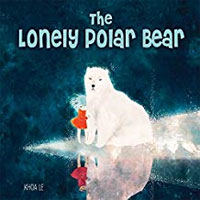 | The Lonely Polar Bear by Khoa Le, 2018 This sweet children’s picture book presents a moving story, set in a fragile Arctic world threatened by global warming. A little polar bear wakes up alone after a furious storm. With his mother nowhere in sight, he makes friends with a mysterious little girl and various animal companions. All of the friends come together in the magnificent polar sky. In the end the little bear sits peacefully, enjoying a winter day lit up by beautiful northern lights. Featuring exceptional illustrations from talented Vietnamese illustrator Khoa Le, The Lonely Polar Bear offers an accessible way to introduce children to climate change issues.
|
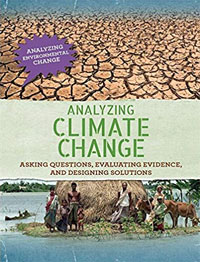 | Analyzing Climate Change: Asking Questions, Evaluating Evidence, and Designing Solutions by Philip Steele, 2018 Scientific evidence clearly shows that temperatures and the level of CO2 in the atmosphere have risen dramatically since the end of the nineteenth century, coinciding with the rise of industrialization. But what can be done to slow the effects of climate change on humans, plants and animals, and natural resources? This book explains the consequences of further climate change, from flooding of coastal areas to unhealthy pollution in urban areas, and how governments, businesses, and citizens can proactively work on limiting their use of greenhouse gases. International accords such as the Paris agreement of 2015 and the Kyoto Protocol of 1992 are also discussed.
|
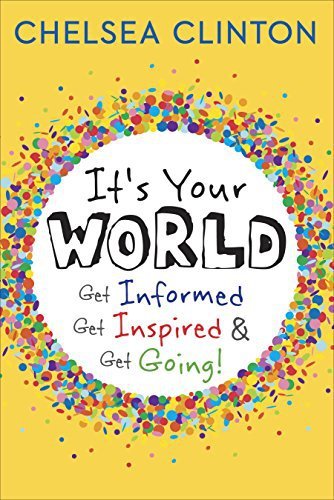 | It’s Your World: Get Informed, Get Inspired, & Get Going by Chelsea Clinton, 2015/2017 First daughter turned activist and mother Chelsea Clinton shows kids how they can make a difference in their world. With an eye toward empowering and inspiring kids, Chelsea Clinton explores some of the biggest challenges facing our world today. Using data, charts and stories she unpacks challenges related to Poverty, Climate Change, Gender Equality, Health, Endangered Species and talks about what’s being done to make a difference — particularly by kids and teenagers. With lots of suggestions and ideas for action, Chelsea Clinton shares her passion for helping others and shows readers that the world belongs to every single one of us, and every one of us counts. You can make a difference. You can make a change. It’s your world.
|
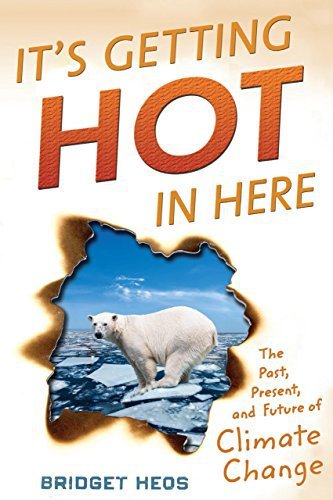 | It’s Getting Hot in Here: The Past, Present, and Future of Climate Change by Bridget Heos, 2016 Tackling the issue of global warming head-on for a teen audience, Bridget Heos examines the science behind it, the history of climate change on our planet, and the ways in which humans have affected the current crisis we face. It’s Getting Hot in Here illustrates how interconnected we are not just with everyone else on the planet, but with the people who came before us and the ones who will inherit the planet after us. This eye-opening approach to one of today’s most pressing issues focuses on the past human influences, the current state of affairs, the grim picture for the future — and how young readers can help to make a positive change.
|
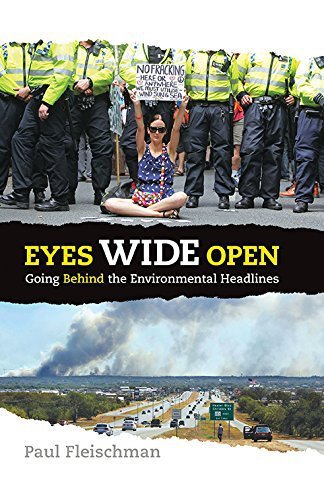 | Eyes Wide Open
|
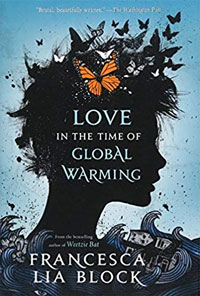 | Love in the Time of Global Warming by Francesca Lia Block, 2013/2014, Teen/Young Adult After the Earth Shaker, which all but destroyed Los Angeles, 17-year-old Penelope (Pen) sets out into the wasteland in search of her family, her journey guided by a tattered copy of Homer’s Odyssey. Soon she begins to realize her own abilities and strength as she faces false promises of safety, the cloned giants who feast on humans, and a madman who wishes her dead. On her voyage, Pen learns to tell stories that reflect her strange visions, while she and her fellow survivors navigate the dangers that lie in wait. In her lyrical style, Francesca Lia Block has created a world that is beautiful in its destruction and as frightening as it is lovely. Love in the Time of Global Warming has shades of science fiction, fantasy, eco-fiction, and dystopia.
|
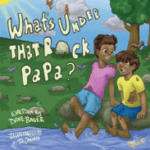 | What’s Under That Rock Papa? By Dave Bauer / Hardcover / Ages 3 – 8 A great read for any grandparent with a child they love! You’ll get lots of easy ways to share time outdoors, in your own backyard! When Serea and Kai spend a weekend at their Grammy and Papa’s home, it’s always a time of discovery and fun! Join them as they encounter the wonders of backyard nature, from the microcosm of life under rocks and compost piles, to the joy of learning why thunder sounds scary and rain clouds are black.With Serea and Kai as their guides, children and adults will be encouraged to join in exploring their own backyards in search of those fascinating moments of discovery fostering inquiry learning and the riches of playing in nature. Visit the website here.
|
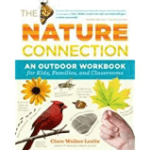 | The Nature Connection, An Outdoor Workbook for Kids, Families, and Classrooms by Claire Walker Leslie, 2010. This interactive workbook is packed with creative, year-round activities for curious naturalists ages 8 to 13. This is a treasure trove of fun, free activities for kids while learning and spending time in the outdoors. |
 | The New 50 Simple Things Kids Can Do to Save the Earth EarthWorks Group, with contributor Sophie Javna The original best-selling book has been revised for a concerned and vibrant Web 2.0 youth market. It’s easy-to-do and kid-friendly projects show that kids can make a difference, and each chapter is packed with tons of links to groups and resources. What makes this book stand out, though, is that it doesn’t just inform kids, it encourages them to make a difference by providing them, their friends and their families the tools to take action.
|
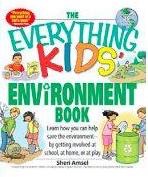 | The Everything Kids’ Environment Book: Learn how you can help the environment-by getting involved at school, at home, or at play By Sheri Amsel / Paperback, age 9 and older In this book kids can find out what they can do every day to help protect our planet. They will also learn why the rainforest is so important to us, how animals go extinct, and what environmentalists can tell us about taking good care of our world.
|
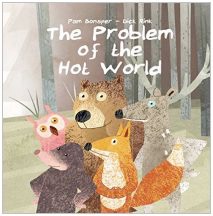 | The Problem of the Hot World By Pam Bonsper and Dick Rink / Pre-school through age 7 Five forest friends notice they are in trouble. Their world is too hot. Plants and bees are disappearing and their beautiful trees are dying. Bear, fox, deer, mole, and owl set off on an action-packed adventure as they look for a solution to the problem. While the solution they find helps them, is it the best way to deal with climate change? Use this book to start the discussion and help children understand the impacts of global warming.
|
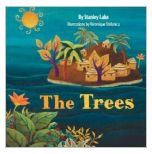 | The Trees By Stanley Lake / Suitable for elementary school A tropical island, where the earth provides ample food and comfort for the island dwellers, where all are friendly with one another and where sharing the bounty from the earth is the norm. But one night a giant storm takes everything away from the villagers and they must learn, as a community, the best way to rebuild and replant. This is a story of looking past the present and finding the best road to the future.
|
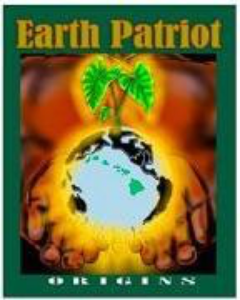 | Earth Patriot: Origins By Howard Shapiro / Kindle edition / for grade 6 through high school “Earth Patriot: Origins” is a young adult novel about a teenager who incorporates into his life the best of traditional Native Hawaiian culture with that of modern society. It also speaks about Hawaiian values and the importance of `ohana, family, as well as addressing a number of environmental issues including climate change, GMOs, and land and water rights. The book is appropriate for readers in grades 6 through high school.
|
 | The Story of Climate Change By Earth Day Network & Michael Leifer / Interactive Book for Grades 5-8 / Free from iTunes This is primarily a textbook for middle school students. This free interactive digital textbook allows educators and students to witness our changing climate through animation, science videos, photographs, and field expedition stories, and check their progress with quizzes at the end of each chapter. The iTextbook not only provides the gripping imagery of our changing climate, but it also offers ideas for action and solutions!
|
 | A Kids’ Guide to Climate Change & Global Warming: How to Take Action! (How to Take Action! Series) – Cathryn Berger Kaye / Grades 6+ A Kids’ Guide to Climate Change and Global Warming is a recent workbook for kids in grade 6 and up in the How To Take Action! Series. It contains a global warming map, carbon footprints explanation, water audits, youth summits, alternative energies, cool foods, green comics and much more to empower kids to take action to reduce or end global warming. Providing step by step suggestions for effective activities, A Kids’ Guide to Climate Change and global Warming is a fine educational tool for young student environmental activists.
|
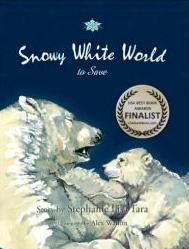 | Snowy White World to Save By Stephanie Lisa Tara / elementary school This powerful and important story brings the plight of the polar bears to readers through lyric writing and gorgeous illustrations. Once the Arctic ice is gone, the beautiful polar bear will no longer have a way to survive. With the ice goes the magnificent creature’s hope. Bears use the ice as a home, for everything from food to birth is tied to the ice. If nothing is done, scientists warn the majestic polar bear could be extinct in fifty years. This amazing journey is full of heart, empathy, and useful information to bring readers into the world of the polar bear and show why these special creatures should be saved. – Alex Walton (Illustrator)
|
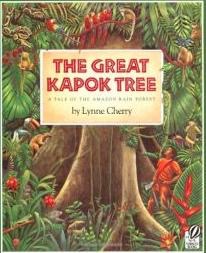 | The Great Kapok Tree By Lynne Cherry / Ages 4-8 If a tree falls in the forest… someone or something will always be there to hear it. Many, many creatures will feel the effects when their source of sustenance and shelter falls to the earth. So when a man is sent into the Amazon rain forest one day, under instructions to chop down a great kapok tree, many eyes watch him nervously. It’s not long before he grows tired, though, and the “heat and hum” of the rain forest lulls him to sleep. One by one, snakes, bees, monkeys, birds, frogs, and even a jaguar emerge from the jungle canopy to plead with the sleeping ax-man to spare their home. When the man awakens, startled at all the rare and marvelous animals surrounding him, he picks up his ax as if to begin chopping again, then drops it and walks away, presumably never to return.
|
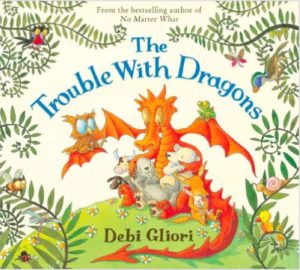 | The Trouble with Dragons By Debi Gliori / Grades K-4 The world is populated by some beastly dragons that care nothing for how much they mess up the oceans, chop down the trees, gobble up all the food and use everything up without stopping to think. Those dragons need to wake up to what they are doing to their world before it is too late … A delightful and energy-filled picture book that addresses concerns about the environment in the most child-centric and delightful way possible.
|
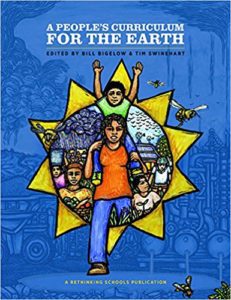 | A People’s Curriculum for the Earth: Teaching About the Environmental Crisis By Five years in the making, A People’s Curriculum for the Earth is a collection of articles, role plays, simulations, stories, poems, and graphics to help breathe life into teaching about the environmental crisis. The book features some of the best articles from Rethinking Schools magazine alongside classroom-friendly readings on climate change, energy, water, food, and pollution–as well as on people who are working to make things better. At a time when it’s becoming increasingly obvious that life on Earth is at risk, here is a resource that helps students see what’s wrong and imagine solutions.
|
